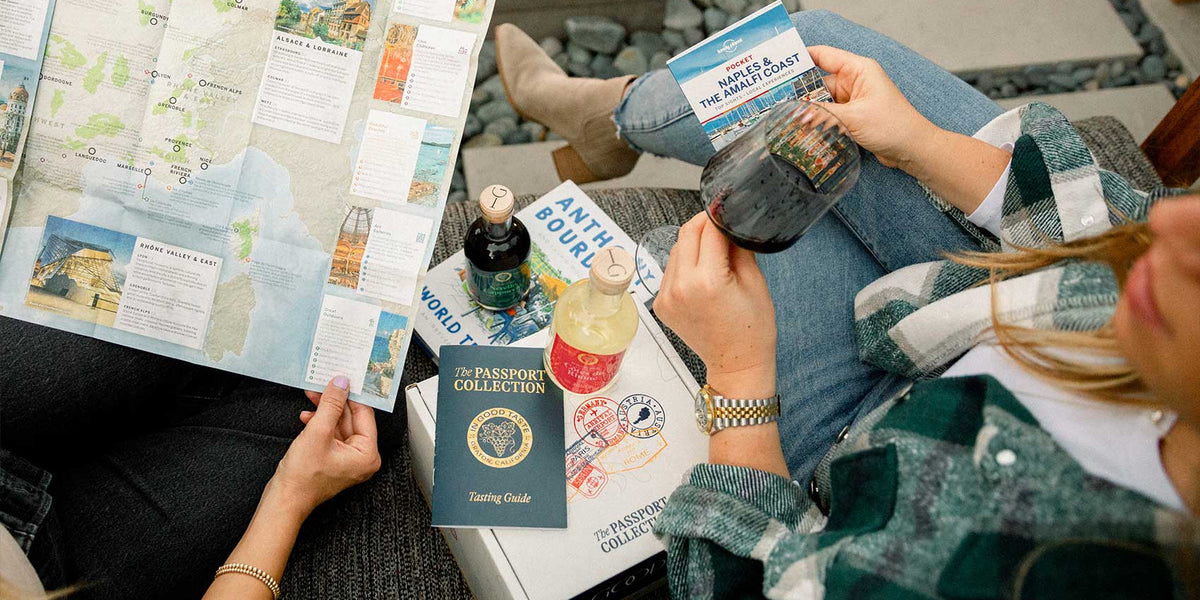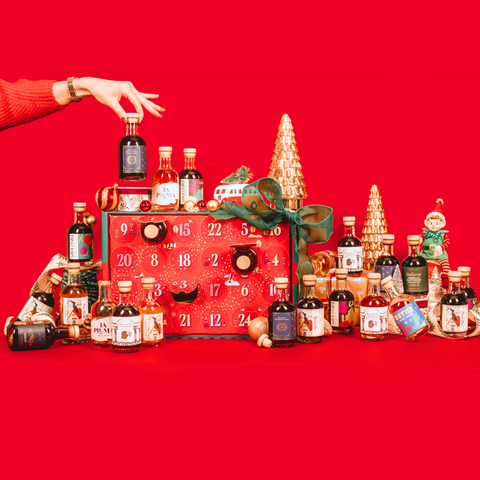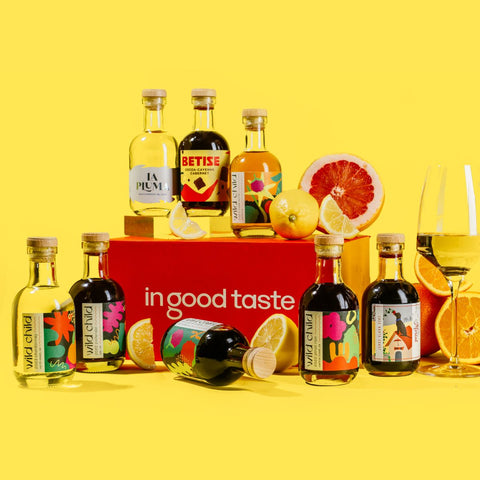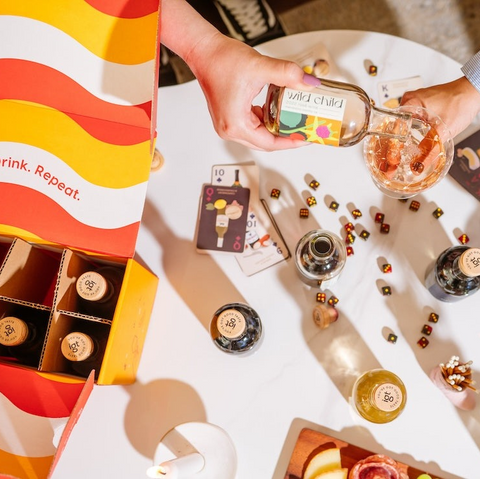A Summary of French Wine
France is one of the world’s most recognized wine-growing countries. While wine was not born in France (that honor goes to Italy), the French brought wine to a whole new level. France produces more fine wine than any other country and is defined by classic varietals such as Champagne, Merlot, Chardonnay, Cabernet Sauvignon, Sauvignon Blanc, Syrah, and Pinot Noir.
The French do not have a word for a winemaker. Instead, they call the vineyard tenders vigneron which means “grape grower.” For the inventors of terroir, location is everything. Appellations like Burgundy and Bordeaux are synonymous with excellence in the wine world.
France is so influential that new wines are constantly being compared to classic French examples (such as the infamous Judgement of Paris in 1976). France is the benchmark against which greatness is judged.
Short History of French Wine Beginnings
France has been making wine for over 2,600 years. Wine was introduced to France by the Etruscans in the years leading up to the Roman empire around 500 B.C. The first French vineyards were found in southern France where the first vignerons emulated Etruscan winemaking techniques.


Beginning of Wine in France
When the Romans took over, they aided the spread of viticulture throughout southern France. Remnants of the Romans’ influence exist across the country. For example, the region of Provence gets its name from the time of Roman’s name for it – nostra provincia or “our province.”
The Catholic church also had a major influence on French wine. Monastic orders such as the Benedictines planted many of the original French vineyards and helped the vines to flourish.

After the French revolution, which lasted from 1789 to 1799, the world of French wine changed forever. Napoleon the First broke the ties between the church and vineyards, selling or giving the vines away to French peasants.
Less than a hundred years later, French vines suffered another major change this time in the form of the root-eating phylloxera insect. In the 1860s, phylloxera found its way into southern France and decimated many French vines before it was discovered that American rootstock was immune to the insect. After phylloxera, wine-growing regions were left significantly smaller than they were before.
Since then the French have gained a reputation for excellence that inevitably resulted in copying. To ensure the quality of French wine, a system of regulations called the Appellation d’Origine Controlee (AOC) was introduced in the 1930s.
French Wine Quality Control: Appellation d'Origine Controlee (AOC)
The Appellation d’Origine Controlee (AOC) was founded for two reasons. One was to prevent cheap wines from claiming the same names of wines from notable regions. The other was the result of the French obsession with where grapes were grown.
The French use the AOC to denote a geographical region that produces excellent wines. The AOC also dictates the practices, traditions, varietals, and techniques that can be used to produce it. The restrictions can be national or region-specific.
Since the introduction of the AOC, Europe has also added its quality control restrictions to the mix. The Appellation d’Origin Protegee (AOP) is similar to the AOC on a larger scale.

Appellation d'Origine Vin De Qualité Supérieure (AOVDQS) is another title normally given to wines just below AOC in the hierarchy. They have similar rules and regulations but are not quite at the same level as AOC.

To make the AOC a bit more complicated, both Grand Cru and Premier Cru fall into the same category, but these titles go even further into defining the level of quality.
Grand Cru is the highest level of classification- referring to a plot of land where grapes were grown or a chateau where the wine was made. An example of a plot of land would be Alsace or Champagne. The only example of a chateau with Grand Cru wines is found in Bordeaux, France.
Premier Cru indicates either a plot of superior quality or an exceptional wine within the Grand Cru classification (labeled Premier Grand Cru… etc).
Outside of the AOC, two less distinctive wine labels exist.
Vin de Pays, which translates to “wine of the land” or “country wine” is also defined by its geographical location, but with less focus on style and tradition. Vin de Pays was introduced in the 1970s. These wines are more experimental and often incorporate new varietals, styles, and techniques.
Vin de France, or Vin de Table, would be considered the lowest tier of wine in France. They do not indicate a region of origin and can be made from wine varietals grown anywhere in France.

French wines are essentially split into four major tiers. Regional wines are at the base and made from grapes grown within the boundaries of France. The more prestige a wine has, the more specific the area. After general regional wines come regional wines from one village, followed by wines made by grapes sourced from premier cru vineyards. Finally, the highest quality wines come from the most prestigious sites or grand cru vineyards.
A Note About Labels
French labeling practices are unique in the wine world. They are a complicated mix of place, producer, and varietal. To the novice, the thick French calligraphy and untranslated descriptions can be extremely intimidating.
Most labels include the following, in no particular order:

Since the French put more emphasis on place than varietal, finding a familiar word on French wine labels can take a little effort. Most AOC wines are known by geographic location (ie. Sancerre, Cotes du Rotie, Volnay, etc) and not by the varietal (i.e. Cabernet Sauvignon, Syrah, etc). Keep reading to learn more about the largest and best-known French wine-growing regions, locations that define excellence throughout France.
French Terroir
For the French, geography and climate matter more than the hands which grow, cultivate, and ferment the wine varietals. Indeed, the concept of terroir was born in France, a concept that has defined modern-winemaking throughout the Old World and the New. The terroir of French wine varies widely depending on the proximity or distance from the coast.
The best wines in the world are grown in some of the worst soil. For example, the poor quality of the soil in Bordeaux helps the vignerons regulate the moisture of the vines which helps prevent certain blights and diseases.
France can be divided into three main regions: north, south, and coast.

Northern France (home to Champagne, Burgundy) has a continental climate, subject to intense winters and cold, rainy autumns. The unpredictable temperature and weather can leave vignerons with unripe grapes which are turned into delicate wines.
Southern France (home to Provence and the Rhone Valley) is influenced by the breeze coming off the Mediterranean sea. The warmer, sunny days and longer growing seasons produce fuller, fleshier wines.
Coastal France (home to Bordeaux and western Loire) is right on the Atlantic coast. The maritime climate is tempered by the Gulf Stream but some rain and humidity can influence winegrowing conditions.
French Wine Regions
The top five most prominent French wine regions are Bordeaux, the Loire Valley, Burgundy, the Rhone Valley, and Champagne. France has 17 regions overall and almost 2,000,000 acres of vineyards.
Approximately 90 percent of French wine uses 36 wine varietals including wine world staples like Chardonnay, Merlot, Sauvignon Blanc, Cabernet Sauvignon, Pinot Noir, and Syrah. Winegrowers from across the world have taken samples of French vines to try and reproduce the success of French vignerons.
BORDEAUX
Popular Varietals: Cabernet Sauvignon, Cabernet Franc, Merlot, Sauvignon Blanc, Semillon, Muscadelle
Well-Known Styles: Red Bordeaux blends, White Bordeaux
Acreage of Vineyards: 300,000 acres
Bordeaux contains 60 appellations and the terroir varies depending on where you are in the region. The best-known styles in Bordeaux are the red wine Bordeaux blends made using a combination of Cabernet Sauvignon, Merlot, Cabernet Franc, Malbec, and Petite Verdot grapes.
This powerhouse region produces some of the best wines in the world. It is divided in two by an estuary and two rivers. The left bank is Cabernet Sauvignon dominant while the right bank is Merlot dominant. Bordeaux is also known for its white wines made with Sauvignon Blanc, Semillon, and Muscadelle.
Bordeaux has inspired many imitators in both the Old World and the New. Washington state produced Bordeaux inspired blend of Semillon and Sauvignon Blanc which reflects the unique terroir of the Northeast United States.
THE LOIRE
Popular Varietals: Chenin Blanc, Sauvignon Blanc, Cabernet Franc, Pinot Noir, Melon de Bourgogne
Well-Known Styles: Sancerre, Pouilly-Fume, Chinon, Saumur-Champigny, Bourgueil, Muscadet Sèvre et Maine, Savennières, Anjou, Saumur, Touraine, Vouvray, Montlouis, Jasnières
Acreage of Vineyards: 185,000 acres
The Loire valley follows the course of the Loire River through western France. While the Loire is known for both red and white wines, the most famous Loire wines are made from Muscadet, Chenin Blanc, Sauvignon Blanc, and Cabernet Franc. There are 51 unique appellations within the Loire Valley and each has its claim to fame.
The Loire is second only to Champagne in the production of sparkling wines- two of which, Vouvray and Saumur, stand out from the crowd.
BURGUNDY
Popular Varietals: Pinot Noir, Chardonnay, Aligote, Gamay
Well-Known Styles: Chablis, Côte de Nuits, Côte de Beaune, Côte Chalonnaise, Coteaux Bourguignons
Acreage of Vineyards: 74,000 acres
Burgundy is known for its high-end wines made from Pinot Noir and Chardonnay, while more rustic styles are made from Aligote and Gamay. Chablis is a Chardonnay dominant sub-region of Burgundy famous for its unoaked Chardonnays. Côte de Nuits produces mostly Pinot Noir, Coteaux Bourguignons primarily Gamay.
When Napoleon divided up the vines after the French revolution, a few strange inheritance laws came into being which continues to influence Burgundy today. Collaborations and cooperatives are common practices in Burgundy where many of the children of those awarded vineyards by Napoleon inherit a single row of vines instead of the whole vineyard.
Australian wine has been greatly influenced by Burgundy. Australia’s Burgundy imitations are also made from Pinot Noir, a varietal that grows well in the sloping topography and cool climate of Adelaide, Australia.
THE RHONE
Popular Varietals: Syrah, Grenache, Mourvèdre, Viognier, Marsanne, Roussanne
Well-Known Styles: Cotes du Rhone, GSM blend, Hermitage, Cote Rotie, Châteauneuf-du-Pape
Acreage of Vineyards: 176,000 acres
The Rhone valley follows the Rhone River through southeast France, a river that divides the valley into distinct north and south banks. The north is known for Syrah and the south for blends made with Grenache, Syrah, and Mourvedre (GSM).
Across the northern and southern banks of the Rhone, the Cotes du Rhone appellation can be found. Red, rosé, or white, Cotes du Rhone has an international reputation for excellence.
CHAMPAGNE
Popular Varietals: Chardonnay, Pinot Noir, Pinot Meunier
Well-Known Styles: Champagne
Acreage of Vineyards: 84,016 acres
Any adult who has celebrated a major life event has probably come across the famous sparkling wine, Champagne. The most notable example, Dom Perignon, was made by a French Benedictine monk in a time when red wines dominated the rest of France. Champagne is generally made from a blend of Pinot Noir, Chardonnay, and Pinot Meunier.

These five regions account for less than half of the total wine growing acreage in France. Other notables include the Alsace for its dry Rieslings, Beaujolais for its lighter-bodied, spicy Gamays, Provence at the base of Mont Ventoux for its Rosés, and Languedoc Roussillon for its up-and-coming organic wines including a selection of reds, whites, rosés, and sparkling wines. France makes prime examples of every classic wine style and the only way to truly know wine from France is to try a variety.

Production, Exports, Imports
France and Italy vie for the title of largest wine producer with an average annual production of 50 to 60 million hectoliters.

A significant portion of the wine made in France is consumed by the French. The French people are fiercely proud of their wine and it isn’t uncommon for a Burgundy native to never try a wine from Bordeaux, or Beaujolais native to never try an Alsatian wine. The average citizen consumes an average of 14 gallons of wine a year.

Total exports of wine from France have doubled over the past decade, from 5.49 billion euros in 2010 to 8.74 billion euros in 2020. However, the growing competition between France and the rest of the wine world has put France at a disadvantage. Its traditions and regulations, which once made it great, are limiting innovation which makes it difficult for vignerons to keep up with changing trends.

Wine and liquor exports are the second largest exported industry in France after aerospace. The United States received most of France’s exports in 2020 (almost a fifth) followed by the UK. In the past couple of years, the US imports of French wine were seriously affected by the heavy wine tariffs imposed by the Trump administration in 2019 and the global pandemic in 2020.
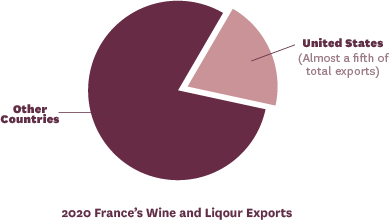
Tourism
Tourism in France is a growing industry. From 2009 to 2016, the number of tourists increased by a third, from 7.5 million to 10 million. The total amount spent by tourists in 2016 was 5.2 billion euros. Even though exports primarily go to the United States, tourism attracts a varied crowd. More than half of French tourists are French, but foreign tourism is on the rise. The largest groups of tourists are from Belgium and Britain, with a growing market in Asia as well.
Sustainability Practices
France does not have a comprehensive system regarding sustainability. However, two programs of notice exist. One is a sustainable agriculture system supported by a small group of wineries. The other is a regional sustainability program in the Champagne region.
The first sustainable agriculture system contains a three-tiered system geared toward increasing biodiversity, decreasing environmental impact, managing fertilizer inputs, and improving water management. If a vineyard meets all of the levels of criteria, it can then display the “High Environmental Value'' title (“Haute Valeur Environnementale” or HVE).
Champagne’s Viticulture Durable en Champagne (VDC) is focused on reducing environmental risks, preservation of terroir and biodiversity, confronting climate change, and waste management.
French Wine Sustainability Certificaions


Overall, sustainability is still a relatively new practice in France. The small changes made by the small group of wineries using the HVE and Champagne’s VDV are at the forefront of French sustainable wine practices.
To Adapt or Hold Fast to Tradition in a Changing World
The nature of French wine, grounded in both tradition and regulation, is a limitation for future generations of vignerons. For years, France was the world’s greatest wine producer in terms of both quality and quantity but growing rivals in the New World, as well as increased competition with its European neighbors, have left France in the past.
Since the beginning of the 21st century, France has been working to reinvent itself both in terms of style and to adapt to the changing global climate. The inclement weather from global warming has also presented a problem for regions that have known nothing but perfect climate and geographic conditions for the past 2000 years.
Fun Facts
-
France is a major producer of grape-based spirits. Armagnac is the world's-oldest brandy and is often confused with France’s other grape-based spirit, Cognac. You can tell the difference between the two by the flavor and weight. Armagnac is deeper, earthier, and darker while Cognac is lighter, fruitier, and finer.
-
27% of wine consumed in France is Rosé, beating out French white wine which only accounts for 16%.
-
Coca-Cola has origins in French wine. In the 1700s a French chemist mixed French red wine with coca leaves- a blend that was said to bring health and vitality to the drinker. Due to difficulties with prohibition legislation, America John Pemberton modified the recipe to be non-alcoholic. Thus, the recipe for modern Coca-Cola was born.
-
During World War II the French were so concerned that the Nazis would destroy the French wine industry that they hid the roots of French wines and most previous bottles in secret cellars to preserve the industry for generations to come.

